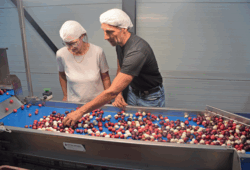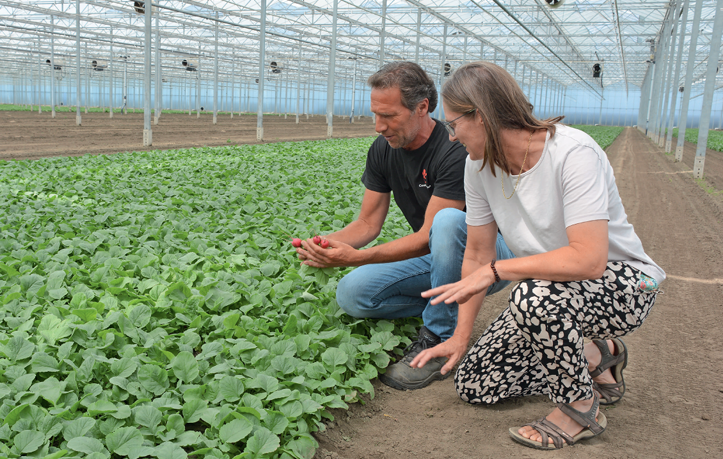The loss of crop protection products that lose their approval places additional pressure on the control of diseases and pests. For small crops with a limited acreage, where the economic interest for authorization holders is minor, it is particularly difficult to retain sufficient corrective agents — let alone to gain access to new active substances. Radish is an example of such a small crop. Previously, radish growers and Coordinator of the Effective Measures Package (CEMP) Jeannette Vriend of Glastuinbouw Nederland already saw active substances such as thiram and iprodione disappear due to European re-evaluations. Now, the seed coating with Maxim, containing the active substance fludioxonil, also risks being phased out. As a result, controlling Rhizoctonia, among other pathogens, will become extremely difficult. And every single product that disappears makes the overall plant health management system even less robust.
Searching for new substances
Jeannette Vriend of Glastuinbouw Nederland: “We are losing active substances because Europe has a very critical assessment framework. This makes the re-registration process of many active substances very difficult. Small crops often suffer disproportionately, but major crops are also heavily affected. In short, I hope the industry continues to defend substances for all crops and remains committed to innovation so that new substances become available. But that’s not easy.” Given the limited economic importance of radish, she is pleased when authorization holders still make an effort for this crop, such as including radish in new label applications or extensions. An example of this is the expansion of the label for Aliette to include radish. Radish grower Ad Coolbergen adds: “That’s really unique. Usually, it’s the other way around — we lose another product instead.” Sometimes, growers are also caught off guard by completely unexpected regulations. For example, the EU suddenly introduced an MRL (Maximum Residue Limit) not only for the radish bulb but also for its leaves. This likely happened because in Italy, the leaves of a radish-related crop were marketed as a product. Fortunately, after much effort and lobbying, the MRL for radish leaves was eventually grouped under that for arugula (rucola). Originally, the foliage would have had to comply with kale standards — which would never have been possible with the usual radish products.
Resilient cultivation
Radish grower Ad Coolbergen in Oude Tonge (South Holland), from the National Radish Committee of Glastuinbouw Nederland, explains: “Rhizoctonia is a recurring problem. It’s often the reason we have to steam the soil. We do this every three years, although ideally, it should be done every year to prevent this fungal disease. But with gas prices continuing to rise, soil steaming will soon become unaffordable for us. Moreover, we already try to do it as little as possible because it destroys all soil life, including beneficial organisms.” Therefore, a more resilient radish cultivation system would be desirable. Coolbergen continues: “We’ve already started adding more to the soil to make it stronger — for example, Trianum — so that harmful fungi and other soil organisms get less of a chance.” Vriend adds that radish growers are taking soil resilience improvement very seriously. “At one of the farms, a practical pilot is being carried out as part of the Practical Program on Resilience. This program is partly funded by Kennis in je Kas (KijK), and the crop cooperative also contributes. The goal is to improve radish cultivation through serious comparative trials. After one year, there’s already a clear improvement in the microbiology of the soil, although this hasn’t yet translated into higher yields. We’ll continue the project for another year.” Coolbergen adds: “While other crops have sometimes doubled in productivity over the years, the yield per hectare of radish has actually decreased. Our first priority, however, is not production. Of course, that’s still important, but our main concern is preventing diseases from affecting the crop.” Normally, the greenhouse is filled with yellow sticky traps to catch insects, but these are temporarily removed to avoid interference during soil steaming.
Restoring soil life
After steaming, a double dose of beneficial soil life is added to help rebuild lost resilience. Organic matter is also incorporated into the soil. Potting soil is steamed in advance as a precaution to avoid introducing pathogens into the soil. In the past, Coolbergen also used chicken manure pellets, which made it possible to apply nutrients gradually and in small doses. “That did attract more cabbage flies, although that’s fortunately only a minor issue here. Some radish growers also report having significant problems with bulb mites, but we don’t have that issue here on the island of Goeree-Overflakkee.” Vriend wonders whether predatory soil mites could be used in the crop. Coolbergen responds: “They’re incredibly expensive. And below eight degrees Celsius, they’re not active — and our crop, which is only kept frost-free, is often close to or below that temperature. So if you have to use predatory mites at one euro per square meter, that becomes very costly.”
Efficient seed coating
As mentioned, seed coating forms a very important foundation for the plant health of radish. Apron (active substance metalaxyl) is an essential tool and is available as a seed coating against fungi such as downy mildew. Coolbergen explains: “In the summer, we can complete three to four growing cycles without using any crop protection products, out of a total of just under eight cycles per year. But by the end of August, we have to be alert again for downy mildew. It’s important that the seed itself already contributes to growing a healthy radish plant. In winter, we mainly grow the variety Autella — a tasty radish that’s less watery than the old variety Donar but much more susceptible to downy mildew. Thanks to the availability of Apron as a seed coating, we’ve had far fewer problems during cultivation and therefore need to apply chemicals much less frequently.” “Such a seed coating works very effectively with a very small amount of product, which is great for sustainability. And even though we always work very carefully, spraying always carries a risk of causing emissions — even though, as a zero-discharge company, we reuse all our water, including rinse water from processing. Another advantage of coating is that pests and diseases are less likely to develop resistance compared to spraying.” Hopefully, coating will also make it possible in the near future to effectively apply natural products directly at the source.


